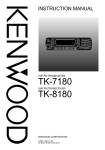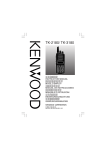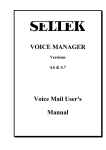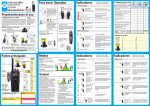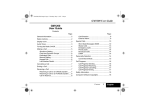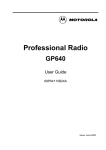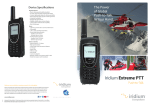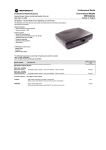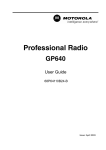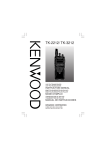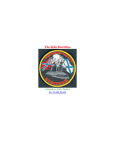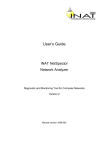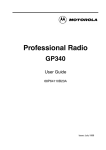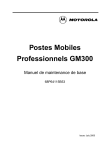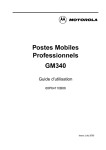Download GM660 Professional Mobile Radio
Transcript
Professional Radio
GM660
User Guide
68P64110B92
Issue: July 2000
7
1
8
2
9
3
10
4
5
11
12
6
15
15
14
13
CONTENTS
Radio Controls . . . . . . . . . . . . . . . . . . . . . . 3
Programmable Buttons . . . . . . . . . . . . . . . 3
Menu Keys . . . . . . . . . . . . . . . . . . . . . . . . . 5
Menu Navigation Chart . . . . . . . . . . . . . . . 6
Keypad Keys . . . . . . . . . . . . . . . . . . . . . . . 7
Keypad Character Table . . . . . . . . . . . . . . 8
LCD Display and Icons. . . . . . . . . . . . . . . . 9
Audio Signal Tones . . . . . . . . . . . . . . . . . 11
Getting Started . . . . . . . . . . . . . . . . . . . . 13
Turning the Radio On-Off. . . . . . . . . . . . . 13
Adjusting the Radio’s Volume . . . . . . . . . 13
Radio Registration . . . . . . . . . . . . . . . . . . 14
Radio Calls . . . . . . . . . . . . . . . . . . . . . . . 15
Making a Call . . . . . . . . . . . . . . . . . . . . . .
Contact List . . . . . . . . . . . . . . . . . . . . . . .
User Absent . . . . . . . . . . . . . . . . . . . . . . .
Dedicated Calls . . . . . . . . . . . . . . . . . . . .
Manual Dialling. . . . . . . . . . . . . . . . . . . . .
Last number Redial . . . . . . . . . . . . . . . . .
Keypad Edit . . . . . . . . . . . . . . . . . . . . . . .
Ending a Call . . . . . . . . . . . . . . . . . . . . . .
15
15
19
20
20
21
21
22
Special Calls . . . . . . . . . . . . . . . . . . . . . .29
Short Data Messages . . . . . . . . . . . . . . . .29
Receiving an SDM . . . . . . . . . . . . . . . .29
Making an SDM Call. . . . . . . . . . . . . . .32
Status Calls . . . . . . . . . . . . . . . . . . . . . . . .34
Making a Status Call. . . . . . . . . . . . . . .34
Receiving a Status Call . . . . . . . . . . . .35
Emergency Calls . . . . . . . . . . . . . . . . . . . .36
Priority Calls . . . . . . . . . . . . . . . . . . . . . . .37
Broadcast Calls . . . . . . . . . . . . . . . . . . . . .37
DTMF. . . . . . . . . . . . . . . . . . . . . . . . . . . . .38
Personality . . . . . . . . . . . . . . . . . . . . . . . .39
MPT . . . . . . . . . . . . . . . . . . . . . . . . . . . . . .39
Talkgroup. . . . . . . . . . . . . . . . . . . . . . . . . .39
Fixed and Dynamic Groups . . . . . . . . .39
Conventional Mode . . . . . . . . . . . . . . . . . .40
Personality Selection . . . . . . . . . . . . . . . . .41
1
English
CONTENTS
Radio Overview . . . . . . . . . . . . . . . . . . . . 3
Cancelling a Call . . . . . . . . . . . . . . . . . . . .22
Receiving a Call. . . . . . . . . . . . . . . . . . . . .23
Receiving a Call on a OACSU System . . 23
Receiving a Call on a FOACSU System. 23
Missed Calls . . . . . . . . . . . . . . . . . . . . . . .24
Call Diversion . . . . . . . . . . . . . . . . . . . . . .27
CONTENTS
Features . . . . . . . . . . . . . . . . . . . . . . . . . 43
Safety Information . . . . . . . . . . . . . . . . . .57
Voice Storage. . . . . . . . . . . . . . . . . . . . . . 43
Voice Recorder . . . . . . . . . . . . . . . . . . 43
Voice Message . . . . . . . . . . . . . . . . . . 47
Safe and Efficient Operation . . . . . . . . . . .57
Exposure to Radio Frequency Energy. . . .57
Electromagnetic Interference/
Compatibility . . . . . . . . . . . . . . . . . . . . . . .58
Operational Warnings . . . . . . . . . . . . . . . .58
Potentially Explosive Atmospheres . . .58
Blasting Caps and Areas . . . . . . . . . . .58
Radio Operation and EME Exposure . . . .59
Mobile Antenna Installation . . . . . . . . . . . .59
Control Station Operation . . . . . . . . . . . . .59
General Radio Care. . . . . . . . . . . . . . . . . .60
Notes . . . . . . . . . . . . . . . . . . . . . . . . . . . . .60
Settings . . . . . . . . . . . . . . . . . . . . . . . . . . 49
External Alarm . . . . . . . . . . . . . . . . . . . . .
Car Radio Mute . . . . . . . . . . . . . . . . . . . .
Data Display. . . . . . . . . . . . . . . . . . . . . . .
Backlight. . . . . . . . . . . . . . . . . . . . . . . . . .
50
52
53
54
Call Progress . . . . . . . . . . . . . . . . . . . . . 55
Call Progress - Sending . . . . . . . . . . . 55
Call Progress - Receiving . . . . . . . . . . 56
Call Progress - Cancelling/Ending . . . 56
Computer Software Copyright
The products described in this manual may include copyrighted computer
programmes stored in semiconductor memories or other media. Laws in the
United States of America and other countries preserve for Motorola Europe
and Motorola Inc. certain exclusive rights for copyrighted computer
programmes, including the right to copy or reproduce in any form the
copyrighted computer programme. Accordingly, any copyrighted computer
programmes contained in the products described in this manual may not be
copied or reproduced in any manner without the express written permission of
the holders of the rights. Furthermore, the purchase of these products shall not
be deemed to grant either directly or by implication, estoppel, or otherwise, any
licence under the copyrights, patents, or patent applications of the holders of
the rights, except for the normal non-exclusive royalty free licence to use that
arises by operation of the law in the sale of the product.
English
2
RADIO OVERVIEW
Please read pages 57 to 60 before using this radio
RADIO CONTROLS
The numbers below refer to the illustrations on
the inside front cover.
1.
On-Off / Volume Knob
Used to turn the radio on or off, and to adjust
the radio’s volume.
Programmable Button 2 h
RADIO OVERVIEW
This user guide covers the operation of the
GM660 Professional Mobile Radio.
9.
10. Edit Buttons Left/Right v or w
11. Programmable Button 3 i
12. Programmable Button 4 j
MICROPHONE CONTROLS
(Keypad Microphone)
13. Keypad
14. Programmable Keys {
}|
15. Push-to-talk (PTT)
Press and hold down this button to talk;
release it to listen.
2.
LED Indicators
Indicate current radio operation.
3.
LCD Display (1 Line)
PROGRAMMABLE BUTTONS
4.
Menu Exit/Escape Button x
5.
Channel Selector/Menu Navigation Up/
Down y or z
When in menu mode, used for menu
navigation. Used for channel scrolling in
conventional mode.
Several of your radio buttons can be
programmed (by Customer Programming
Software CPS) to activate the radio features.
6.
Menu Enter/Select Button c
7.
Mic Jack
8.
Programmable Button 1 g
The following table shows the features that can
be assigned to the P1-P4 buttons and the A,
B, C buttons on the keypad microphone.
-
3
English
RADIO OVERVIEW
Feature
Description
Dedicated Call/Emergency
To make a call to a pre-determined number. This can be an emergency
number, effectively activating an Emergency Call.
Personality
Short cut to the personality menu option to select one of sixty (60) radio
personalities,
(e.g. MPT trunking system or conventional system).
Missed Calls
Short cut to the Missed Call menu option.
This is a list of calls received and stored by the radio when you were
unable to take the call.
User Absent
To switch the User Absent feature On and Off.
This feature is used to indicate to the caller that you are away from your
radio and unable to take calls.
External Alarm
To switch the External Alarm feature On and Off.
Car Radio Mute
To switch the Car Radio Mute feature On and Off.
Data Display
English
To switch the Data Display feature On and Off.
Record/Play-back
(Voice Recorder)
To record/play-back incoming calls or memo using
voice recorder feature.
Record/Play-back
(Voice Message)
To record / play a greetings message using the voice message feature.
4
Menu Keys
Exit
Up
x
c
v
y
z
Left
Down
Right
w
Menu/Select Key c
Used to enter the Menu Mode. When you are in the
Menu Mode, this key is also used to make menu
selections.
Note: When the radio is in the IDLE STATE,
pressing any of the six menu keys causes
the radio to enter the Menu mode.
Exit Key x
Used to move up to the next higher Menu level.
When the top level menu is selected this key is
used to exit the Menu Mode. Also used to cancel/
end calls.
Up /Down Key y / z
Up used for scrolling when in Menu Mode.
Down used for scrolling when in Menu Mode.
Right Key w
Used as More key to provide additional information.
Left Key v
Used as a destructive backspace key when editing.
Refer to the menu navigation chart for menu
selectable features.
5
English
RADIO OVERVIEW
Menu/
Select
RADIO OVERVIEW
Menu Navigation Chart
(Refer to Menu Navigation guidelines lower, left-hand corner of this page)
y/z
Missed
Calls
Contact
List
Personality
Voice
Storage
Settings
select/ ID status/
voice/
voice playback
select/
enter ID
select/
1,2....etc
y/z
y/z
Status
select/
enter ID
c
Data Calls
User
Absent
select/
enter ID
y/z
on/off
Menu Navigation
c to enter Menu Mode.
on/off
y/z
Voice
Recorder
Voice
Message
select/
record/
play/
delete
select/
record
ref:
Missed
Calls for
playback
search/
edit entry
Add
Contact
Delete
Contact
External
Alarm
Car Radio
Mute
Data
Display
y/z
off
low
medium
high
Backlight
y / z to scroll through the list.
c to select Menu item.
y / z to scroll through sub-list.
x to return to previous menu level.
c to select sub-menu item.
English
6
Keypad Keys (Keypad Microphone)
2
5
8
0
3
6
9
#
{ } |
These keys are used when dialling a phone number,
making a radio call or entering information for
programming the radio’s lists.
Each key can generate several different characters.
For example, to enter the character “C”, press the
2 key three times.
Pressing # will toggle between the upper and
lower case of the selected character.
7
English
RADIO OVERVIEW
1
4
7
*
If the next character required is on the same key,
press w to move the cursor forward one character.
If an error is made, press v to delete the current
character and move cursor back one character.
For full character set, refer to the following table.
{}| keys are programmable by your dealer.
RADIO OVERVIEW
Entering Characters using the Keypad
Number of Times Key is Pressed
Key
1
2
3
4
5
6
7
8
9
10
0 +
-
0
x
*
/
=
>
<
#
1 .
1
?
¿
!
,
@
-
&
2 A
B
C
2
Ä
Å
¥
Á
À
3 D
E
F
3
É
È
Ê
Ê
Ë
4 G
H
I
4
Ì
Í
5 J
K
L
5
³
6 M
N
O
6
Ñ
Ñ
Ö
Ò
Ó
7 P
Q
R
S
7
Œ
8 T
U
V
8
Ü
Ù
9 W
X
Y
Z
9
*
#
English
11
12
13
14
15
16
17
:
“
(
)
‘
%
£
$
Æ
ß
Ç
Æ
Ú
Space
Use this key to toggle between UPPER CASE and lower case of the selected character
8
LCD Display and Icons
Name and Description
F
Voice Recorder Indicator
Indicates that there are stored messages or
memos in the voice recorder.
H
The display indicates personality, menu, and
radio status information.
The top screen row above the 1 information
line, shows radio status indicator icons or
symbols, explained in the table below:
Symbol
A
B
C
E
Emergency
Indicates the external feature is enabled.
K
Data Calls List Indicator
On, indicates a data call in the list
Flashing, indicates new unread calls.
L
Registered Indicator
Indicates that a system has been acquired,
and monitor in conventional mode.
Name and Description
XPAND™ Indicator
Indicates that your radio has the
companding feature activated.
Power Level Indicator
‘L’ lights when your radio is configured to
transmit in Low Power. ‘H’ lights when your
radio is configured to transmit in High
Power.
Scan Indicator
Indicates that you are scanning for a
system.
M
Signal Quality Indicator
Shows the radio signal quality. Five bars
indicates the best signal.
N
Option Board Indicator
Indicates that an option board is activated.
Loudspeaker Indicator
Indicates that you have the loudspeaker
active.
9
English
RADIO OVERVIEW
Menu
Symbol
RADIO OVERVIEW
Symbol
D
Q
Name and Description
Contact List Edit Indicator
Flashing indicates user is editing the
contact list.
Missed Calls Indicator
On, indicates there are missed calls in the
missed call list.
Flashing, indicates new unread calls.
Note: At extremely low temperatures, you may
experience a slight delay in displaying new
information. This is normal and does not
affect the function of your radio.
English
10
Audio Signal Tones (Standard)
Tone
Self test
Signal
Tone
Signal
Description
Low pitched tone
Description
Key click
Confidence tone when
any key pressed or
Speech limitation alert.
Fail tone
Hardware error or
Call timed out
(conventional mode).
Power up.
Tone A
Call clear indication.
Tone B
Traffic channel
allocated or PTT/ Mic/
Loudspeaker enabled.
Tone I
Low battery warning.
Tone K1
Voice Storage recording.
Tone C1
System busy.
Tone K2
Voice Storage warning.
Tone C2
Unavailable.
Tone K3
Voice Storage full.
Tone C3
Called party busy.
Tone M1
Talkgroup Confirmation.
Tone C4
Invalid number.
Tone M2
Talkgroup unavailable.
Call set up in progress,
wait for further
indications.
Tone N1
Out of range alert.
Tone D
Tone F
Transaction
confirmed, called unit
will call back.
Tone G
Look at display for
call set up or
System information.
Tone H
Invalid entry.
Ring
tones
Standard/
English/French/
General
Incoming call, press
PTT, then wait for
further indications.
11
English
RADIO OVERVIEW
High pitched tone
RADIO OVERVIEW
Audio Signal Tones (Alternative)
Tone
Signal
Description
High to Low pitched tones
Tone
Signal
Tone H
Invalid entry.
Key click
Confidence tone when
any key pressed or
Speech limitation alert.
Fail tone
Hardware error or
Call timed out
(conventional mode).
Tone I
Low battery warning.
System busy.
Tone K1
Voice Storage recording.
Unavailable.
Tone K2
Voice Storage warning.
Tone K3
Voice Storage full.
Tone M1
Talkgroup Confirmation.
Tone M2
Talkgroup unavailable.
Tone N1
Out of range alert.
Description
Self test
Power up.
Tone A
Call clear indication.
Traffic channel
allocated or PTT/ Mic/
Loudspeaker enabled.
Tone B
Tone C1
Tone C2
Tone C3
Called party busy.
Tone C4
Invalid number.
Tone D
Call set up in progress,
wait for further
indications.
Tone F
Transaction
confirmed, called unit
will call back.
Tone G
Look at display for
call set up or
System information.
English
12
Ring
tones
Standard/
English/French/
General
Incoming call, press
PTT, then wait for
further indications.
GETTING STARTED
ADJUSTING THE VOLUME
ON
Push the On/Off/
Volume Control knob
until you hear a click.
Turn the On/Off/Volume Control knob
clockwise to increase the volume, or
counterclockwise to decrease the volume.
OFF
Push and hold the On/
Off/Volume Control
knob for 2 seconds.
13
English
GETTING STARTED
TURNING THE RADIO ON OR OFF
GETTING STARTED
RADIO REGISTRATION
When turned on, the radio enters a self test routine
during which time the display is activated, the self
test tone will sound and the LED will light green.
If the radio fails the self test a continuous low tone
will sound and the display will show a failure
message. e.g.
Synth Lock
until the radio is turned off.
Note: If the radio fails the self test routine, consult
your dealer.
When the self test is complete the radio will display:
Freetext
This display is for the personality last used. To check
the radio personality or select a new personality refer
to PERSONALITY - Personality Selection.
After this text has been displayed, the radio will scan
for system access with the LED on the top of the
radio flashing GREEN and the scanning icon H
lit.
When a system is acquired, the green LED will go
off, the scanning icon H will be replaced by the
registered icon L and the display will show:
Idle Freetext
English
14
RADIO CALLS
The radio is capable of making a variety of
calls, including calls to individual radios,
groups of radios and calls to private and public
telephone systems.
Before you can make a call the radio must be
in the IDLE STATE, as displayed above, i.e. a
personality has been selected and no call is in
progress.
The radio can make calls by using the Contact
List, Dedicated Calls or Manual Dialling
(using keypad microphone).
1
c to enter Menu Mode.
2
y/z until:
Contact List
3
c to select:
Contact List
4
y/z until:
w to display
w to display
w to return to
Alpha Alias
5
When the radio is in the IDLE state, the contact
list may be used which allows access to up to
100 preprogrammed numbers accessed via
the menu.
Depending on the way your radio is
programmed, the radio will display either the
alpha alias (name) or the number to be dialled.
One of four tones may be tagged to the preprogrammed numbers, which will sound when
the radio receives a call from that number.
Ring Tone
Alpha Alias
c or PTT button to make radio call.
Display shows:
Contact List
Number
Calling
Alias/Number
6
After the call is set-up, press PTT button and
talk with your mouth 2.5-5 cm from microphone. Release PTT to listen.
7
When finished with call.
15
English
RADIO CALLS
Making a Call
To access the contact list via the menu:
RADIO CALLS
8
To Add an Entry
CLEAR BUTTON or
x or
*#
1
c to enter Menu Mode.
2
y/z until:
Add Contact
3
c to select:
Add Contact
Call Ended
Tone A sounds
If a contact list number is selected but no call
request is sent, the display is held until tone H
sounds and then reverts to the IDLE STATE.
When the number is displayed it may be edited
as described in the Keypad Edit section.
You will see:
Name?
4
Use the keypad to enter the name (see pages
7 and 8). A maximum of 14 characters is
allowed, depending on programming.
Modifying the Contact List
(Keypad Microphone only)
You can modify the Contact List in three ways:
5
c to store the name.
1.
Add an entry
6
2.
Delete an entry
Use the keypad to enter the number (see
pages 7 and 8). A maximum of 20 digits is
allowed, depending on programming.
3.
Edit an existing entry
7
c to store the number.
You will see:
Note: The radio cannot receive any calls while you
are modifying the contact list.
You will see:
8
English
16
Number?
Add Contact
If you make an error, use the v key to delete
the last character/digit and the w key to
create a space.
To Delete an Entry
To Edit an Entry
c to enter Menu Mode.
1
c to enter Menu Mode.
2
y/z until:
Delete Contact
2
y/z until:
Contact List
3
c to select:
Delete Contact
3
c to select:
Contact List
4
y/z until you see the entry you want to
You will see current
entry e.g.:
4
edit.
Alias 1
y/z until you see the entry you want to
You will see e.g :
delete.
5
You will see e.g :
5
c to select the entry.
You will see:
6
Alias 2
v for 2 seconds to enter Edit Alias Mode
when display icon D flashes.
You will see current
entry e.g.:
Alias 3
Delete?
6
Use the keypad to edit the alias (see pages 7
and 8) or delete and enter a new alias.
Use the v key to delete the last character
and the CLEAR key to delete entire entry.
7
c to store edited/new alias.
c to delete the selected entry.
Display returns to:
Alias 3
Delete Contact
You will see
associated number
e.g :
01256488116
17
English
RADIO CALLS
1
RADIO CALLS
8
9
Use the keypad to edit the number (see pages
7 and 8) or delete and enter a new number.
Use the v key to delete the last digit and the
CLEAR key to delete entire entry.
c to store the edited entry.
Display returns to:
To Search for an Entry
When in Contact List or Delete Contact menu, you
may search for an alias (name) by entering
characters from the keypad.
1
Alias 3
2
Enter up to 3 characters from the keypad
e.g.:
c to start search of list:
Display shows search
result e.g.:
3
Pol
Police
* to repeat search using same search
criteria
4
x to cancel search at any time,
or
If search unsuccessful display returns to
contact list menu prior to search.
Note: The search process is not case sensitive.
English
18
User Absent
1
c to enter Menu Mode.
2
y/z until:
User Absent
3
c to select:
User Absent
4
y/z until:
On
5
c to select:
On
6
Followed by:
7
Selected
(held for 10 seconds,
then display returns to
idle)
CLEAR button to exit Menu Mode.
Display shows:
Idle Freetext
1
c to enter Menu Mode.
2
y/z until:
User Absent
3
c to select:
User Absent
4
y/z until:
Off
5
c to select:
Off
6
Followed by:
7
CLEAR button to exit Menu Mode.
Display shows:
RADIO CALLS
User Absent can be selected on your radio
when you are unable to take calls. Any calls to
your radio will be put into the Missed Calls list
automatically and the message ‘Will Call Back’
is sent to the caller.
User Absent may be switched on and off
directly by pressing the dedicated User Absent
button (if programmed).
To switch on User Absent via the menu:
When you are able to take calls, ensure that
User Absent is switched off by:
Selected
(held for 10 seconds,
then display returns to
idle)
Idle Freetext
User Absent may be permanently enabled in
your radio via programming. With this feature
enabled, entry into the user absent mode is
automatic and any calls received when you are
away from your radio will be put into the
19
English
RADIO CALLS
Missed Calls list automatically and the
message “Will call back” sent to the caller.
When you return to your radio, check whether
tone G sounds every 10 seconds which
indicates that your radio is in user absent
mode. Press any button to exit user absent
mode and return the radio to the idle state for
normal operation.
Manual Dialling
(Keypad Microphone only)
To make a call from the keypad (13):
1
Enter
2
PTT button or # to make radio call.
Dedicated Calls
Dedicated calls can be made from either a
preprogrammed dedicated call button or using
the speed-dial feature from the keypad.
Press the Dedicated Call button to make a call
to the most commonly used pre- programmed
number. The selected number and then the
alias will be displayed and the conversation
can go ahead.
To use the speed-dial feature, hold down one
of the keypad keys (0 to 9) for a preset period
to make a call to one of ten (1 of 10)
preprogrammed numbers which are the first
ten entries (1 to 9, 0 = 10) in the contact list.
The display will show “Calling”.
English
20
Display shows:
Telephone Number
(PSTN calls always
start with 0)
(PABX call numbers
depend on the network and radio programming,
or
Radio ID
or
Group ID
Calling
Alias/Number
Last Number Redial
If the radio is displaying a Contact List number,
a Keypad Dialled number, Status number or
Missed Call number, the last digit may be
deleted by:
For Contact List numbers:
1
PTT button
2
PTT button or # to make radio call.
1
v Once
(to select number)
1234567
Display shows:
2
v Again
(to delete last digit)
123456
Number
Calling
Number
For all other numbers:
The number may also be edited, see Keypad
Edit .
Last number redial does not function when
MPT Talkgroup Select personality is selected,
see PERSONALITY - Personality Selection.
3
v Once
(to delete last digit)
123456
4
Enter new numbers
12345699
5
PTT button or # to make radio call.
Display shows:
Calling
Alias/Number
Note: The edited number is not saved at the end of
the call in contact list, but is saved as last
number redial.
21
English
RADIO CALLS
The last number dialled by the radio is stored
in the memory of the radio.
Partially entered numbers are also stored.
With the radio in the IDLE STATE:
Keypad Edit
(Keypad Microphone only)
RADIO CALLS
Ending a Call
Cancelling a Call
Always end a call by:
At any time while setting up a call it may be
cancelled by:
1
CLEAR BUTTON or
x or
1
*#
Tone A sounds
Call Ended
See "Call Progress - Ending a Call".
English
22
CLEAR BUTTON or
x or
*#
Cancelling
See "Call Progress - Cancelling a Call".
Receiving a call on an FOACSU system
There are two types of systems on which the
radio may be used, Off Air Call Set Up (OACSU)
and Full Off Air Call Set Up (FOACSU).
When the radio is called:
If you are in doubt about which system you are
operating on, please consult your dealer.
1
Ringing tone sounds
2
PTT button or # to accept call.
(Unless in talkgroup personality, when the
radio unmutes automatically for dynamic and
fixed group calls.)
3
Tone D sounds
Caller ID
4
Tone B sounds
(when conversation
is permitted)
Call Type
Receiving a call on an OACSU system
When the radio is called:
1
Tone D sounds
Caller ID
2
Tone B sounds
Call Type
For display Call Type see "Call Progress Receiving"
Caller ID
For display Call Type see " Call Progress Receiving"
Note: The system may have a limited call time,
indicated on the display, and the call may be
terminated automatically if this call time is
exceeded.
e.g.
Display shows:
Call Type
00:20
23
English
RADIO CALLS
Receiving A Call
To view the calls in the list via the menu:
RADIO CALLS
Missed Calls
If a call remains unanswered, the call will be
stored by the radio, provided that missed calls
have been programmed via the CPS.
Up to ten calls can be stored. If the same radio
calls more than once the call is only stored
once. When ten calls have been stored by the
radio, depending on the radio programming,
the eleventh call received may overwrite the
first or not be stored by the radio.
When a call has been stored by the radio, tone
G will sound every ten seconds, the Missed
Call icon Q will flash and the display will
show:
Missed Calls
With the display showing ‘Missed Calls’ ,
pressing any of the menu buttons provides a
quick access into the Missed Calls List.
The Missed Call List can also be entered
directly by pressing the Missed Call button (if
programmed) when the radio is in the IDLE
STATE or via the menu.
If using the Missed Call button, follow the
procedures from step 4 below.
English
24
1
c to enter Menu Mode.
2
y/z until:
Missed Calls
3
c to select:
Missed Calls
4
First call in list
Alpha Alias
5
y/z to scroll list:
Alpha Alias
Note: In the Missed Calls list some alpha alias/
numbers may contain a suffix S or V.
S indicates a status message associated
with the call, and V indicates a voice
message associated with the call.
Examples:
Display shows
Bob V
where BOB is the alias of the calling unit and V is
a voice (answerphone) message associated with
the call
w
w
2
Display shows
1
y/z until:
2
PTT button or # or c to make radio
call.
To playback the voice
message.
To skip to end of
message.
Display shows:
Calling
Alias/Number
3
After the call is set-up, press PTT button and
talk with your mouth 2.5-5 cm from microphone. Release PTT to listen.
Reception S
4
Displays message e.g.
On Break
w again
Displays status number
e.g.
Status 04
w again
Display shows
Reception S
CLEAR button or
x or
*#
where S is a status message associated with the
call
w
Selected Alias
5
Tone A sounds
Call Ended
Display shows
Idle Freetext
Note: Whilst displaying alias, l will allow
number to be displayed and edited.
25
English
RADIO CALLS
1
You can call back to any number in the Missed
Call list by:
RADIO CALLS
On a successful call set- up, the entry is
automatically deleted from the list together with
an associated voice message.
Unanswered calls may be deleted from the
Missed Call list at any time by pressing:
1
2
Delete?
c (or *# or CLEAR button)
to delete missed call from the list.
3
x to retain missed call in list.
4
*# deletes the currently selected
missed call with no display prompt.
On deletion of the last message in the Missed
Calls list, the radio will exit the menu and return
to the IDLE STATE.
English
26
1
x button
or
MISSED CALL button to exit Menu Mode.
Display shows:
CLEAR button
Display shows:
To exit the Missed Call List:
Idle Freetext
Note: The calls in the stack are not deleted when
the radio is turned off. It is not possible to
call back status calls.
Call Diversion (Keypad Microphone only)
1
*41
From your radio
2
*44
From another radio
1
Will divert all calls from your radio to the radio
with ID “234”
2
When the radio is in the IDLE STATE, call
diversion can be initiated by:
1
2
*41*
or
*44*
To divert all calls
*411* To divert speech
calls only
or
*441*
3
*412* To divert status/
data calls only
or
*442*
4
Enter ID of radio to which you are diverting
5
#
*41*234#
*44*234*
432#
Will redirect all calls from the radio with ID “234”
to the radio with ID“432”
If a call is made to a radio whose calls are
currently being diverted:
1
Tone D sounds
Diverting
A call is automatically set up to the radio which is
receiving the diverted calls
To complete call
diversion
27
English
RADIO CALLS
Incoming speech calls or status/data calls can
be diverted by:
Examples:
RADIO CALLS
To cancel Call Diversion:
1
To cancel call diversion from your radio
#41 followed by 1 or 2 if
necessary and
#.
2
To cancel call diversion from another radio
#44 followed by 1 or 2 if
necessary and
* “ID” (234 in example) #.
3
To cancel calls redirected to your radio
#45 followed by 1 or 2 if
necessary and
#.
English
28
SPECIAL CALLS
Displaying Incoming Data
Short data messages may be set up, sent and
received using the keypad microphone and
controls.
Outgoing data messages from the keypad are
limited to alphanumeric data in any
combination of up to 20 characters (which
include address information and data selection
characters).
The short data message display can be
switched ON and OFF using the preprogrammed Data Display button, or using the
keypad microphone or via the menu. Refer to
Settings - Data Display for details.
The SDM display defaults to ON, however the
option setting is retained when the radio is
switched off.
Receiving Short Data Messages
Note: This feature is important when you are away
from your vehicle, to prevent loss of data
messages.
On receiving a Short Data Message:
Storing SDMs
1
Tone G sounds
Data Received
The data message icon K is lit whenever
SDMs are in the data message calls list, i.e.
displayable, unless the message display has
been turned off (refer to Displaying Incoming
Data). Note that the data message icon
flashes when data messages in the calls list
are unread. The icon is lit permanently when a
message is read and retained in the calls list.
Incoming SDMs are stored on receipt in the
Short Data Message Calls List. Up to ten
SDMs can be stored by the radio. The data
message icon K is lit whenever SDMs are in
the calls list.
SDMs are not stored when the radio is
switched OFF, except for one SDM only which
can be saved.
29
English
SPECIAL CALLS
Short Data Messages (SDM)
SPECIAL CALLS
Interrogating the SDM Calls List
When an SDM call has been stored by the
radio, the display will show:
Data Received
With the display showing ‘Data Received’ ,
pressing any of the menu buttons provides a
quick access into the Data Calls List.
To view the calls in the list via the menu:
1
c to enter Menu Mode.
2
y/z until:
Data Calls
3
c to select:
Data Calls
4
First call in list
Alpha Alias
or
Number
5
y/z to scroll list:
Alpha Alias
or
Number
English
30
6
c or w to read
selected message:
7
At end of message:
8
x to retain message in list and exit from
data messages
9
x again to exit from Menu Mode
e.g.
Call 8116
w or x to return
to data calls list.
1
Read the data message in the Data Calls List.
2
c
You will see:
Deleting Messages from the Data Calls List
1
To delete data messages from the data calls
list or while viewing data messages.
2
CLEAR button
Display shows:
Save?
3
c to save selected message.
4
x will not save selected message, display
3
Delete?
c (or *# or CLEAR button)
to delete data message from the calls list.
will return to Data Calls List.
When the radio is switched off and on again the
saved SDM will appear in the Data Calls List.
Note: You must exit the data message calls list
interrogate mode to put the radio in the idle
state in order to make other calls.
4
x to retain data message in the calls list.
5
*# deletes the currently selected data
message with no display prompt.
6
Radio returns to the data calls list interrogate
mode after each deletion until the last message is deleted when the display returns to
the idle state and the data message icon K
is extinguished.
You can move directly from the Data Calls List
to the Missed Calls List by pressing the Missed
Calls button. Once in the Missed Calls List the
functionality is as detailed in RADIO CALLS Missed Calls.
31
English
SPECIAL CALLS
To save an SDM to be retained after the radio
is switched off.
SPECIAL CALLS
Making an SDM Call
SDM Calls may be initiated in two different
ways:
1.
Via the keypad using a Call modifier
2.
Via the Contact List
Note: The maximum data message size is limited
to 20 characters which includes address
information and data selection characters.
Data entered via the data button or call modifier methods may be alphanumeric characters entered from the keypad.
In the contact list method data may consists
alphanumeric characters which are pre-programmed into your radio by your dealer.
To initiate a data call via the keypad:
1
*2*
2
Enter message from keypad in alphanumeric
characters (ref pages 7 & 8)
3
*
Final part of modifier
4
Enter
Called radio address
5
Display shows:
y/z to
scroll message:
6
English
32
*2*Call Bryan
ASAP*NNN
(where NNN is called radio
address.)
Press PTT button or # to make a call to the
dialled numbers
Tone D sounds
Display shows:
7
Part of modifier
Sending Data
Press CLEAR button or *# at any time
to delete dialled numbers and return radio to
IDLE STATE when tone H sounds
To initiate a Data call via the contact list
2
y/z until:
Contact List
3
c to select:
Contact List
4
y/z until:
w to display
w to display
w to return to
Alpha Alias
Number
Ring Tone
Alpha Alias
5
c or PTT button to make radio call.
Display shows:
6
7
SPECIAL CALLS
In this method data may consist of alphanumeric
characters which are pre-programmed into your
radio by your dealer.
1 c to enter Menu Mode.
Sending Data
When finished with call.
CLEAR BUTTON or
x or
*#
Tone A sounds
Call Ended
Note: The maximum data message size is limited
to 20 characters which includes address
information and data selection characters.
33
English
SPECIAL CALLS
Status Calls
Make the call by:
A status is a code for transmitting prearranged
messages, e.g. status “04” may indicate
“On Break”.
1
Press PTT button or # to make a call to
the dialled numbers
Display shows:
Making a Status Call
Status Calls may be initiated in two different
ways:
1.
Via the keypad using a Call modifier
2.
Via the Menu
To initiate a status call via the keypad:
Sending Status
To initiate a status call via the menu:
1
c to enter Menu Mode.
2
c to select:
3
y/z until:
Status
Status Message e.g.
On Break
1
*0
Part of modifier
2
04
Example of status
digits in range 1-31
3
*
Final part of modifier
4
c to select:
Status 04
4
Enter
Called radio address
5
Select Contact
5
Display shows:
Display shows for 10
seconds
6
c to display:
34
Status Number e.g.
Status 04
*004*NNN
Where NNN is called radio address.
English
w
Current entry in
contact list
7
y/z until:
Alpha Alias
8
9
Alternatively, a valid
number can be
dialled from the
keypad.
Your radio receives a Status Call when:
1
Tone G sounds
2
Display shows:
e.g.
*004*207
c or PTT button or # to make a call to
the dialled numbers
Display shows:
SPECIAL CALLS
(required name or
number)
Receiving a Status Call
Sending Status
Note: c only functions when in contact list
menu mode.
Status 04
or
On Break
Alias/Number
Where Status message “04” / “On Break” is
example status message. Note that status
number (04) only will be displayed if associated
message is not programmed into your radio.
Alias/Number is the name or number of the
calling radio.
35
English
SPECIAL CALLS
Emergency Calls
3
An emergency call allows you the highest form
of priority calling and normally takes
precedence over all other calls.
Your radio can be programmed to give you a
one-button quick access to call a particular
radio or centre (predefined by your dealer) in
emergency situations.
Conversely you can dial the number, prefixing
it with * 9 * (keypad microphone only).
To initiate an emergency call:
1
Press the Emergency button
or
2
*9* followed by the radio number
and PTT or #.
Tone D will sound and
Display shows:
Emergency can be stopped by one of the
following:
1.
Switching the radio Off and On again.
2.
Pressing the CLEAR button.
3.
The emergency time duration is reached.
Note: The emergency time duration is
programmed into your radio by your dealer.
Your radio may receive an emergency call
when:
Emergency
Tone D or Ringing
Tone will sound and
Display shows:
or
English
Press the Footswitch (if programmed as
emergency button)
With radio OFF
a. Press footswitch to turn radio ON
b. Press footswitch again to send emergency
call.
With radio ON
a. Press footswitch once to send emergency
call.
36
Emergency
Broadcast Calls (Keypad Microphone only)
A priority call allows you to gain priority over
other users of the system when requesting a
call.
To initiate a priority call:
A broadcast call allows you to make calls to
groups of radios. Note that on a broadcast call
only the calling radio can talk and there is no
indication that any radios in the group have
received the call.
To initiate a broadcast call:
1
*8* followed by the number and
PTT or #.
1
Tone D will sound and
Display shows:
*11* followed by the group
number and PTT or #.
Priority
See " Call Progress - Sending".
Tone D will sound and
Display shows e.g. :
*11*90
37
English
SPECIAL CALLS
Priority Calls (Keypad Microphone only)
SPECIAL CALLS
DTMF (Keypad Microphone only)
DTMF means Dual Tone Multi Frequency and
is used when the radio is required to operate in
a radio system with an interface to telephone
systems.
An access code, which is system dependent, is
normally needed for DTMF, please contact
your dealer or network manager for further
information.
To initiate a DTMF call:
1
Enter Access code
2
Press and hold PTT
3
Enter desired number
English
38
PERSONALITY
MPT
This personality permits the radio to operate in
a trunked mode. Incoming and outgoing calls
are set up using a defined set of rules or
protocol between your radio and a controller in
a similar manner to your home telephone. Your
radio ‘registers’ onto an MPT trunked system
as described in GETTING STARTED - Radio
Registration.
Talkgroup is an MPT personality following the
same rules or protocol, but is primarily for
talkgroup calls. In talkgroup personality,
talkgroups are contained in a Talkgroup list,
similar to the Contact list, which is scrolled and
selected using the Up/Down keys (5).
On selection of a talkgroup, you may send and
receive calls as described below.
Fixed and Dynamic Groups
These groups form part of the Talkgroup
Personality, such that when this personality is
selected your talkgroup list shows only these
groups.
A fixed group is a group of users, the address
(number/alias) of which is preprogrammed into
your radio by your dealer.
A dynamic group is a group of users, the
address (number) of which is sent to your radio
‘over air’ at any time via the system controller.
Therefore at any time you may become a
member of a dynamic group, able to receive
calls and (depending on how your radio is
programmed) send calls to that group.
39
English
PERSONALITY
The personalities described below are
programmed into your radio by your dealer and
are accessible either via the personality button
or via the menu.
A radio personality contains data such as
frequencies, display text, alert tones, permitted
calls etc. which determines the mode of
operation of your radio. Your radio may be
programmed with up to 4 different
personalities, selected from MPT, Talkgroup
and Conventional.
Talkgroup
PERSONALITY
Incoming calls to fixed and dynamic group
numbers are detailed in Receiving a Call and
displayed under Call Progress - Receiving.
To make an outgoing call to a selected
talkgroup, press the PTT to set-up the call.
Press PTT and speak after the confidence
tone.
Calls are cleared in the normal manner.
If the system is busy an engaged tone will be
heard, release the PTT and wait for the
confidence tone. You may then proceed with
the call by pressing the PTT.
When in Talkgroup personality, you can still
make an individual or status call using the
keypad or entering the Contact List via the
menu as detailed in RADIO CALLS - Contact
List.
English
40
Conventional Mode
In the conventional mode your radio operates
as a standard two-way radio.
Select the personality “Conventional” as
described in Personality Selection, the
display shows:
Channel xx
where xx is the channel number. Use the Up/
Down keys (5) to display and select the desired
channel.
Prior to transmission always make sure that
the channel is free (red LED not flashing).
Press the PTT to transmit, release to listen.
The red LED lights while the radio transmits
and flashes if the channel is busy.
Some channels may be monitored for activity
by pressing the clear button. The L icon will
be displayed until the channel is changed or
the clear button is pressed again.
Personality Selection
Personality selection may be entered directly
by pressing the Personality button. You may
then scroll and select a personality as
described from step 6 below.
To select a personality via the menu:
1
Ensure radio is in IDLE STATE.
2
c to enter Menu Mode.
3
y/z until:
Personality
4
c to select:
Personality
5
Display shows
current personality
e.g.:
MPT
6
7
y/z until
desired
personality e.g.:
Conv Pers
c to select:
Conv Pers
41
English
PERSONALITY
In the conventional mode, the radio is equipped
with a time out timer. A speech limitation alert
tone will sound a few seconds before the
transmitter in your radio is switched off.
The call timed out tone will sound and continue
until the PTT is released.
To generate DTMF tones, press and hold the
PTT while entering the desired number.
PERSONALITY
8
The display will be held for 2 seconds while
your radio retunes to the new personality.
Your radio will return
to the idle state:
English
42
Freetext
FEATURES
Voice storage allows you to perform various
voice related tasks which include voice
recorder and voice message facilities.
You can record and playback incoming calls or
make a memo using the voice recorder feature,
which allows up to 2 minutes of recording.
To record an incoming call:
1
c to enter Menu Mode.
2
y/z until:
Voice Storage
3
c to select:
Voice Storage
4
y/z until:
Recorder
5
c to select:
Recorder
6
Press and hold the Record/Playback button,
the Voice Storage Recording alert sounds
momentarily.
7
Record the call or part of the call.
8
The Voice Storage Warning alert sounds
when the memory is nearly full.
9
The Voice Storage Full alert sounds when the
memory is full and recording ceases.
43
English
FEATURES
VOICE STORAGE
Voice Recorder
FEATURES
10 Release the Record/Playback button at any
time to stop recording.
11 Subsequent messages can be stored by
repeating steps 6 to 10.
Note: All recorded messages are retained when
changing between personalities, with the
exception of conventional personalities
where the voice storage feature is not available. However all recorded messages are
deleted on selection of the voice message
feature.
English
44
To record a memo:
Ensure radio is in IDLE STATE.
2
c to enter Menu Mode.
3
y/z until:
Voice Storage
4
c to select:
Voice Storage
5
y/z until:
Recorder
6
c to select:
Recorder
7
Press and hold the Record/Playback button,
the Voice Storage Recording alert sounds
momentarily.
You will see:
11 Release the Record/Playback button at any
time to stop recording.
Recording
8
Speak clearly into the radio microphone to
record your memo.
9
The Voice Storage Warning alert sounds
when the memory is nearly full.
You will see:
Storage Low
45
English
FEATURES
1
10 The Voice Storage Full alert sounds when the
memory is full and recording ceases.
You will see:
Storage Full
FEATURES
To playback a recorded call or memo:
1
Ensure radio is in IDLE STATE.
12 c current message deleted. Display
shows next message.
2
c to enter Menu Mode.
Alternatively, with radio in IDLE STATE
3
y/z until:
Voice Storage
1
4
c to select:
Voice Storage
Press the Record/Playback button to playback
the first recorded call or memo.
You will see:
Playing
5
y/z until:
Recorder
2
Press the Record/Playback button again to
skip to the next message to be played back.
6
c to select:
Recorder
7
c to select:
Messages
8
y/z to select
To delete a recorded call or memo:
message:
9
c to play selected message.
10 After playing message display shows:
Delete?
11 x display shows next message without
deleting current message.
English
46
1
Playback message as described in above
in alternative procedure.
2
Press the Clear button to delete the message
currently being played back.
e.g.
Message 02
Voice Message
1
Ensure radio is in IDLE STATE.
2
c to enter Menu Mode.
3
y/z until:
Voice Storage
4
c to select:
Voice Storage
5
y/z until:
Message
6
c to select:
Message
7
You will see:
On/Off
8
c to select:
On
9
You will see (for 10
seconds):
Selected
You will see:
11
Press and hold the Record/Playback button,
the Voice Storage Recording alert sounds
momentarily.
You will see:
Record Msg
Recording
12
Speak clearly into the radio microphone to
record your message.
13
Ensure that your greetings message is as
short as possible to enable maximum incoming messages to be recorded.
14
Release the Record/Playback button at any
time to stop recording.
15
Press the Record/Playback button to playback
the greetings message.
You will see:
16
Playing
You can change the message at any time by
repeating the above procedure.
Note: If you select the voice recorder feature, or
change personality you will have to record a
new greetings message.
47
English
FEATURES
You must pre-record a greetings message to
be played to a caller automatically when you
are absent and the voice message facility is
selected. Your radio will auto-record messages
from callers in your absence as long as you
have selected the voice message facility and
pre-recorded a greetings message.
To pre-record a greetings message:
10
FEATURES
To playback a message from callers:
1
Enter the Missed Calls list as detailed in
RADIO CALLS - Missed Calls.
2
Any calls having a V suffix have an associated
voice message e.g. Bob V.
3
y/z until:
4
r to playback the message.
4
r again to skip to end of message.
5
The message is automatically deleted when
the associated missed call is answered or
deleted.
English
48
Bob V
SETTINGS
SETTINGS
The settings described below are programmed
into your radio by your dealer and are
accessible either via a programmable button or
via the menu.
49
English
SETTINGS
EXTERNAL ALARM
Using the External Alarm Button
The external alarm feature activates the
vehicle horn and/or lights to inform you of an
incoming call when you are away from your
vehicle.
1.
Press the External Alarm button to switch on
External Alarm, when the feature enable alert
will sound and the E icon will be illuminated.
2.
Press the External Alarm button again to
switch off External Alarm when the feature
disable alert will sound and the E icon will be
extinguished.
Note: This feature will not operate when in a
conventional personality.
When the alarm is activated it can be cancelled
by:
1. Answering the call.
2. Calling party terminates the call.
3. The call is placed in the Missed Calls list.
4. The call times out.
You can switch On or Off the External Alarm
by using a pre-programmed External Alarm
button when the radio is in the IDLE STATE or
via the menu.
English
50
Using the Menu
Ensure radio is in IDLE STATE.
2
c to enter Menu Mode.
3
+ or e until:
Settings
4
c to select
Settings
5
+ or e until:
External Alarm
6
c to select
External Alarm
Display shows
current status e.g. :
Off
7
+ or e until:
On
8
c to select
On
Display shows:
(for 2 seconds)
Selected
9
SETTINGS
1
Radio exits menu and returns to IDLE STATE
51
English
SETTINGS
CAR RADIO MUTE
This feature allows you to switch on and off the
car radio mute feature. The Car Radio Mute
automatically mutes your in-car audio
entertainment system to allow you to hear
incoming calls or to stop audio interference
when you are making a call.
Using the Menu
1
Ensure radio is in IDLE STATE.
2
c to enter Menu Mode.
3
+ or e until:
Settings
4
c to select
Settings
5
+ or e until:
Car Radio Mute
You can switch On or Off the Car Radio Mute
by using a pre-programmed Car Radio Mute
button when the radio is in the IDLE STATE or
via the menu.
6
c to select
Car Radio Mute
Display shows
current status e.g. :
Off
Using the Car Radio Mute Button
7
+ or e until:
On
8
c to select
On
Display shows:
(for 2 seconds)
Selected
Note: This feature will not operate when in a
conventional personality.
1.
Press the Car Radio Mute button to switch
on Car Radio Mute, when the feature enable
alert will sound.
2.
Press the Car Radio Mute button again to
switch off Car Radio Mute when the feature
disable alert will sound.
English
52
9
Radio exits menu and returns to IDLE STATE
DATA DISPLAY
You can switch On or Off the Data Display by
using a pre-programmed Data Display button
when the radio is in the IDLE STATE, or using
the keypad or via the menu.
1
Ensure radio is in IDLE STATE.
2
c to enter Menu Mode.
3
+ or e until:
Settings
4
c to select
Settings
5
+ or e until:
Data Display
6
c to select
Data Display
Display shows
current status e.g. :
Off
7
+ or e until:
On
8
c to select
On
Display shows:
(for 2 seconds)
Selected
Using the Data Display Button
1.
2.
Press the Data Display button to switch on
the Data Display, when the feature enable alert
will sound.
Press the Data Display button again to switch
off Data Display when the feature disable alert
will sound.
SETTINGS
This feature allows you to switch on and off the
data display. This is important when you are
away from your vehicle, to prevent loss of data
messages. Refer to Special Calls -Short Data
Messages for a detailed description of this
feature.
Using the Menu
Using the Keypad (Keypad Microphone only):
1.
Enter *23000# to turn OFF the
incoming short data display.
2.
Enter *23001# to turn ON the
incoming short data display.
9
Radio exits menu and returns to IDLE STATE
53
English
SETTINGS
BACKLIGHT
Using the Menu
This feature allows you to alter the brightness
of the radio display to suit conditions.
1
Ensure radio is in IDLE STATE.
2
c to enter Menu Mode.
3
+ or e until:
Settings
4
c to select
Settings
5
+ or e until:
Backlight
6
c to select
Backlight
Display shows
current status e.g. :
Off
You can set the display backlight brightness to
Off, Low, Medium or High via the menu.
7
8
9
English
54
+ or e until
e.g.:
Medium
c to select
Medium
Display shows:
(for 2 seconds)
Selected
Radio exits menu and returns to IDLE STATE
CALL PROGRESS
Tone
D
Display
Comment
Unobtainable
Call unobtainable
C2
Unavailable
Unit unavailable
C4
Invalid Number
Unit number invalid
C1
System Busy
System busy, try again
D
Alerting
Alerting called unit
C3
Engaged
Called unit is busy
Calling
Trying to connect call
Priority
Priority call sent,
modifier *8* used
F
Will Call Back
User absent, called unit
will call back
Emergency
Emergency call sent,
modifier *9* used
C2
Call Fail
Call failed, try again
D
Sending Status
Status call sent,
modifier *0xx* used (xx is
status message number)
C2
Timeout
Call request timed out.
Check service is available
D
Sending Data
SDM call sent,
modifier *2* used
H
Scanning
System access lost, try
again
G/D
Queued
Call queued on system
D
Diverting
Calls to called unit have
been diverted
D
D
55
English
CALL PROGRESS
When in operation, your radio monitors each
step in setting up a call whether sending or
receiving. These steps are displayed to provide
you with call progress and indicate call types.
Call Progress - Sending
C2
CALL PROGRESS
Call Progress - Receiving
Tone
D
Display
B
Dynamic NN
Dynamic group call
received (may be alias
or number - NN)
Comment
Alerted
Caller ID
A call is being received
on OACSU
B
Group NN
Ring
Tone
Alerted
Caller ID
A call is being received
on FOACSU. Press PTT
or ‘#’ to accept the call
Fixed group call
received (may be alias
or number - NN)
B
System Wide
Call to all radios in use
on the system
D/
Ring
Tone
Emergency
Emergency call being
received
B
Broadcast
Broadcast call received,
user reply not permitted
B
Alias/Number
Call from radio in your
fleet
G
Status XX
Receiving status
message (xx is status
message number)
B
Interfleet
Call from radio in
another fleet
G
Data Received
Receiving data
message
B
Telephone
Calls from public
telephone system
Call Progress - Cancelling/Ending a call
B
PABX
Calls from private
telephone system
D/G
Cancelling
Call identity unknown to
the system
Call successfully
cancelled by user
A
Call Ended
Call ended, another call
can now be made
B
B
English
Tone
Unknown Party
Talkgroup NN
56
Talkgroup call received
(NN is list number)
Display
Comment
SAFETY INFORMATION
This section provides information and instructions for
the safe and efficient operation of Motorola Mobile
Two-Way Radios.
For information regarding radio use in hazardous
areas, please refer to the Factory Mutual (FM)
approval manual supplement or Instruction Card
which is included with radio models that offer this
capability.
Exposure To Radio Frequency Energy
National and International Standards and
Guidelines
Your Motorola Two-Way Radio, which generates and
radiates radio frequency (RF) electromagnetic energy
(EME) is designed to comply with the following National
and International Standards and Guidelines regarding
exposure of human beings to radio frequency
electromagnetic energy:
•
Federal Communications Commission Report and
Order No. FCC 96-326 (August 1996)
•
American National Standards Institute
(C95.1 - 1992)
National Council on Radiation Protection and
Measurements (NCRP - 1986)
•
International Commission on Non-Ionizing Radiation Protection (ICNRP - 1986)
•
European Committee for Electrotechnical
Standardisation (CENELEC):
• ENV. 50166-1
1995 E
Human Exposure to Electromagnetic Fields Low Frequency (0Hz to 10kHz)
• ENV. 50166-2
1995 E
Human Exposure to Electromagnetic Fields High Frequency (10kHz to 300GHz)
• Proceedings of
SC211/8 1996
Safety Considerations for
Human Exposure to E.M.F.s
from Mobile Telecommunications Equipment (M.T.E.) in
the Frequency Range
30MHz - 6 GHz (E.M.F. Electromagnetic Fields)
To assure optimal radio performance and that
human exposure to radio frequency electromagnetic
energy is within the guidelines set forth in the above
standards, always adhere to the following
procedures:
57
English
SAFETY
Safe and Efficient Operation of Motorola
Two-Way Radios
•
SAFETY
Electromagnetic Interference/Compatibility
Potentially Explosive Atmospheres
Note: Nearly every electronic device is susceptible
to electromagnetic interference (EMI) if
inadequately shielded, designed or otherwise configured for electromagnetic compatibility.
Turn off your two-way radio when you are in any
area with a potentially explosive
atmosphere.
Sparks in a potentially explosive atmosphere can
cause an explosion or fire resulting in bodily injury or
even death.
To avoid electromagnetic interference and/or
compatibility conflicts, turn off your radio in any
facility where posted notices instruct you to do so.
Hospitals or health care facilities may be using
equipment that is sensitive to external RF energy.
When instructed to do so, turn off your radio when
on board an aircraft. Any use of a radio must be in
accordance with airline regulations or crew
instructions.
Operational Warnings
Vehicles Equipped with
Airbags
!
WARNING
An airbag inflates with great force.
DO NOT place objects, including communication
equipment, in the area over the airbag or in the airbag
deployment area. If the communication equipment is
improperly placed and the airbag inflates, this could
cause serious injury.
English
58
Blasting Caps and Areas
To avoid possible interference with blasting
operations, turn off your radio when you are near
electrical blasting caps, in a blasting area, or in
areas posted: “Turn off two-way radio.” Obey all
signs and instructions.
Note:
The areas with potentially explosive atmospheres
referred to above include fueling areas such as:
below decks on boats; fuel or chemical transfer or
storage facilities; areas where the air contains
chemicals or particles, such as grain, dust or metal
powders; and any other area where you would
normally be advised to turn off your vehicle engine.
Areas with potentially explosive atmospheres are
often but not always posted.
Mobile Antenna Installation
To assure optimal radio performance and that
human exposure to radio frequency electromagnetic
energy is within the guidelines referenced earlier in
this document, transmit only when people inside
and outside the vehicle are at least the minimum
distance away from a properly installed, externally
mounted antenna.
Table 1 lists the minimum distance for several
different ranges of radiated power.
Install the vehicle antenna external to the vehicle
and in accordance with:
Table 1: Radiated Power and Distance
Radiated Power of
Vehicle-installed
Mobile Two-way Radio
Minimum Distance
From Transmitting
Antenna
7 to 15 Watts
30.5 cm(1 Foot)
16 to 50 Watts
61 cm (2 Feet)
More than 50 Watts
91.5 cm (3 Feet)
•
The requirements of the antenna manufacturer/
supplier
•
Instructions in the Radio Installation Manual
Control Station Operation
When radio equipment is used to operate as a
control station, it is important that the antenna
be installed outside the building and away from
places where people may be in close proximity.
Refer to Table 1 for rated power and minimum
distant values for transmitting antennas.
59
English
SAFETY
Mobile Radio Operation and EME Exposure
NOTES
General Radio Care
!
• The use of chemicals such as
detergents, alcohol, aerosol
Caution
sprays, and/or petroleum
products may be harmful to and damage the
radio housing.
• Avoid physical abuse of the radio.
• Clean the radio exterior using a cloth moistened
with clean water and a mild dishwashing liquid.
• The use of non-approved radio accessories may
damage the radio and invalidate warranty.
English
60
NOTES






























































